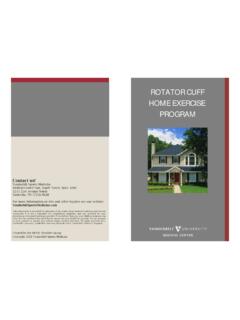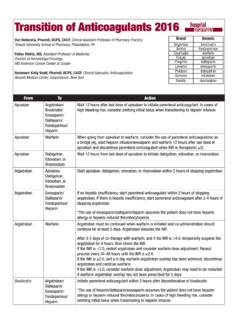Transcription of Venous Thromboembolism Prophylaxis Guidelines
1 VANDERBILT UNIVERSITY MEDICAL CENTER MULTIDISCIPLINARY SURGICAL CRITICAL CARE Venous Thromboembolism Prophylaxis Guidelines Purpose: To provide guidance on preventing Venous Thromboembolism (VTE) in the surgical intensive care unit (SICU) at Vanderbilt University Medical Center (VUMC). Background: The incidence of VTE in general surgical patients not receiving Prophylaxis ranges from 15-30% for deep vein thrombosis (DVT) and for pulmonary embolism (PE).[1] Both low dose unfractionated heparin (LDUH) and low molecular weight heparin have been shown to significantly reduce the risk of VTE when compared to no Prophylaxis in general surgery patients.[2-5] The Chest Guidelines recommend using a risk stratification score to determine the type of VTE Prophylaxis for general and abdominal-pelvic surgery patients [6]. However, these scores can be cumbersome, have many limitations, and have not been validated in the critically ill.
2 The ideal pharmacologic agent for VTE Prophylaxis in surgical patients depends on the type of surgery being performed and the patients specific risk factors. Studies examining the general surgery population have shown no difference in symptomatic VTE between LDUH and LMWH.[1] In orthopedic, multi-trauma, and malignancy, LMHW has been shown to be superior to LDUH.[7-9] Some advantages of using LMHW are a lower incidence of heparin-induced thrombocytopenia (HIT) and once daily dosing. Disadvantages of LMHW are possible increased rates of minor bleeding, renal dosing adjustments, cost, and a contraindication with epidurals. Due to the diversity of patients admitted to the SICU, VTE Prophylaxis must be individualized based on each patient s risk factors for VTE and bleeding (see Table). Risk Stratification for VTE1 Procedures Patient Specific Factors Low Laparoscopic cholecystectomy Appendectomy Transurethral prostatectomy Inguinal herniorrhapy Unilateral/bilateral mastectomy Ambulating/mobilization Age < 40 years with no additional risk Moderate Gynecologic (non-malignancy) surgery Cardiac surgery Thoracic surgery Spinal surgery for malignancy Bariatric surgery BMI > 25 kg/m2 Age 40-60 years with no additional risk Estrogen therapy High Open-abdominal Open-pelvic Age > 60 years Prior VTE Malignancy Anesthesia 2 hours Bed rest 4 days Postpartum Hospital stay > 2 days Long bone fractures Contraindications to Pharmacologic VTE Prophylaxis .
3 Heparin o Active bleeding o Heparin-Induced Thrombocytopenia (HIT) enoxaparin o Active bleeding o Heparin-Induced Thrombocytopenia (HIT) o Epidural catheter - enoxaparin thromboprophylaxis will not be used 12 hours prior to epidural placement, while the catheter is indwelling, or for 24 hours after removal. o Intra-cranial Pressure (ICP) Monitor o External Ventricular Drain (EVD) Initiation for Pharmacologic VTE Prophylaxis : All patients admitted to the SICU should be started on VTE Prophylaxis on admission to the unit unless they have a contraindication or one of the following: Intra-cranial hemorrhage start 72h after injury Craniotomy start 72h after procedure Significant spinal injury/surgery start 24h after injury or surgery Treatment Flow Diagram: VTE Prophylaxis GuidelineHigh Risk for VTE: Trauma Ortho MalignancyModerate Risk for VTE: Age > 60 Prolonged OR Immobility Prior VTE PostpartumLow Risk for VTE.
4 Ambulating No additional risk factorsEarly ambulation & SCD sCrCl 30 ml/minCrCl 20-29 ml/minCrCl <20 ml/minEnoxaparin 40mg q24hOR enoxaparin 30mg q12h** enoxaparin 30mg q24hHeparin 5,000 units SubQ q8h**Preferred dosing regimen for Trauma patients is enoxaparin 30mg q12hCrCl 30 ml/minCrCl 20-29 ml/minCrCl <20 ml/minEnoxaparin 40mg q24h ORHeparin 5,000 units SubQ q8h enoxaparin 30mg q24h ORHeparin 5,000 units SubQ q8h Heparin 5,000 units SubQ q8h Special Population: Obese Patients [10-14] Heparin: If enoxaparin is contraindicated, higher doses of low dose unfractionated heparin may be used. o Dosing: Heparin 7,500 units subQ q8h enoxaparin : Obese patients with a BMI > 40 may benefit from higher doses of enoxaparin for VTE Prophylaxis and monitoring of low molecular weight heparin assays (anti-Xa levels). o Dosing: BMI >40 = enoxaparin 40 mg subQ q12h (normal renal function) BMI > 50 = may consider enoxaparin 60mg subQ q12h (normal renal function) o Monitoring Low molecular weight heparin assay (Anti-Xa levels) should be obtained 4 hours after the 3rd or 4th dose Goal level = Holding VTE Prophylaxis : Epidural Placement/Removal o Heparin: Hold dose prior to epidural placement and removal o enoxaparin : Hold VTE Prophylaxis for 12 hours for placement or removal of epidural catheter VTE Prophylaxis can be resumed 2 hours after removal of epidural catheter Sequential Compression Devices (SCDs) It is the SICU practice to have SCDs ordered on every patient on admission to the unit.
5 Authors: Kelli Rumbaugh, PharmD, BCPS Stephen Gondek, MD Sarah Davis, ACNP Date Last Updated: January 2015 References 1. Agnelli G: Prevention of Venous Thromboembolism in surgical patients. Circulation 2004, 110(24 Suppl 1):IV4-12. 2. Geerts WH, Heit JA, Clagett GP, Pineo GF, Colwell CW, Anderson FA, Jr., Wheeler HB: Prevention of Venous Thromboembolism . Chest 2001, 119(1 Suppl):132S-175S. 3. Mismetti P, Laporte S, Darmon JY, Buchmuller A, Decousus H: Meta-analysis of low molecular weight heparin in the prevention of Venous Thromboembolism in general surgery. The British journal of surgery 2001, 88(7):913-930. 4. Clagett GP, Reisch JS: Prevention of Venous Thromboembolism in general surgical patients. Results of meta-analysis. Annals of surgery 1988, 208(2):227-240. 5. Collins R, Scrimgeour A, Yusuf S, Peto R: Reduction in fatal pulmonary embolism and Venous thrombosis by perioperative administration of subcutaneous heparin.
6 Overview of results of randomized trials in general, orthopedic, and urologic surgery. The New England journal of medicine 1988, 318(18):1162-1173. 6. Gould MK, Garcia DA, Wren SM, Karanicolas PJ, Arcelus JI, Heit JA, Samama CM, American College of Chest P: Prevention of VTE in nonorthopedic surgical patients: Antithrombotic Therapy and Prevention of Thrombosis, 9th ed: American College of Chest Physicians Evidence-Based Clinical Practice Guidelines . Chest 2012, 141(2 Suppl):e227S-277S. 7. Planes A, Vochelle N, Mazas F, Mansat C, Zucman J, Landais A, Pascariello JC, Weill D, Butel J: Prevention of postoperative Venous thrombosis: a randomized trial comparing unfractionated heparin with low molecular weight heparin in patients undergoing total hip replacement. Thrombosis and haemostasis 1988, 60(3):407-410. 8. Colwell CW, Jr., Spiro TE, Trowbridge AA, Morris BA, Kwaan HC, Blaha JD, Comerota AJ, Skoutakis VA: Use of enoxaparin , a low-molecular-weight heparin, and unfractionated heparin for the prevention of deep Venous thrombosis after elective hip replacement.
7 A clinical trial comparing efficacy and safety. enoxaparin Clinical Trial Group. The Journal of bone and joint surgery American volume 1994, 76(1):3-14. 9. Geerts WH, Jay RM, Code KI, Chen E, Szalai JP, Saibil EA, Hamilton PA: A comparison of low-dose heparin with low-molecular-weight heparin as Prophylaxis against Venous Thromboembolism after major trauma. The New England journal of medicine 1996, 335(10):701-707. 10. Borkgren-Okonek MJ, Hart RW, Pantano JE, Rantis PC, Jr., Guske PJ, Kane JM, Jr., Gordon N, Sambol NC: enoxaparin thromboprophylaxis in gastric bypass patients: extended duration, dose stratification, and antifactor Xa activity. Surgery for obesity and related diseases : official journal of the American Society for Bariatric Surgery 2008, 4(5):625-631. 11. Freeman A, Horner T, Pendleton RC, Rondina MT: Prospective comparison of three enoxaparin dosing regimens to achieve target anti-factor Xa levels in hospitalized, medically ill patients with extreme obesity.
8 American journal of hematology 2012, 87(7):740-743. 12. Scholten DJ, Hoedema RM, Scholten SE: A comparison of two different prophylactic dose regimens of low molecular weight heparin in bariatric surgery. Obesity surgery 2002, 12(1):19-24. 13. Wang TF, Milligan PE, Wong CA, Deal EN, Thoelke MS, Gage BF: Efficacy and safety of high-dose thromboprophylaxis in morbidly obese inpatients. Thrombosis and haemostasis 2014, 111(1):88-93. 14. Miller MT, Rovito PR: An approach to Venous Thromboembolism Prophylaxis in laparoscopic Roux-en-Y gastric bypass surgery. Obesity Surgery 2004, 14(6):731-7.















